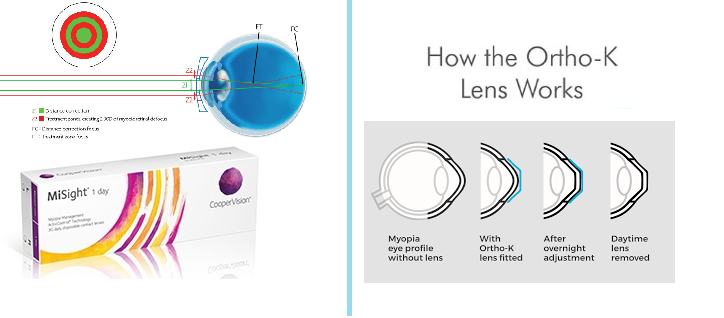
With the rise in myopia (short sightedness) and advances in contact lens technology, we are going to analyse the advantages and disadvantages of the top 2 options for slowing down the progression of myopia.
MiSight Daily Disposables
MiSight daily disposables corrects both myopia and also slows down the progression of myopia in children. A daily disposable lens manufactured by CooperVision is the latest in technological breakthrough offering a comfortable and simple care free system. The proven Proclear material requires no cleaning or maintenance, with low dehydration rates, good all day comfort.
So How Does It Work?
Using ActivControl Technology which results in clear distance, intermediate and near vision. The periphery or the outer parts of the lens are designed so that the lens creates a myopic retinal defocus that has been shown to control the progression of myopia. It has similar characteristics as multifocal lenses.
Pro's & Con's
ADVANTAGES
1. They are safe and easy to use with no cleaning or maintenance. If you lose them then you have replacements.
2. Low infection risk, statistically 2 in 10,000 wearers per year.
3. For low levels of Myopa (-1.00 or less), MiSight are a better choice than Ortho-K for vision correction and Myopia control.
4. More comfortable to wear and easy to adapt to. Clear vision is immediate from the first day.
5. Fewer appointments needed to be fitted as compared to Ortho-K and lower consultation fees.
DISADVANTAGES
1. Prescription range availability with MiSight is more limited at the moment, up to -6.00 of Myopia.
2. No correction for astigmatism is available, thus can compromise vision with those children who have moderate astigmatism. Astigmatism of -0.75 or less may be ok.
3. With a standard fitting shape and diameter, its a one size fits all approach, thus if the lens does not fit properly, it may cause the vision zones to be misaligned, which may affect the quality of the vision.
4. As these are daytime lenses its hard to monitor the childs activities. If they were to go swimming, take a shower or get dirt in their eyes during play, this may increase the risk of infection.
Orthokeratology (Ortho-K)
Ortho-K has been prescribed by thousands of speciality contact lens practitioners worldwide for around 25 years now. So it has been around! These are rigid lenses designed to slow or even halt the progression of Myopia (short sightedness)
So how does it work?
These are rigid (hard) contact lenses that are fitted with precision mapping of the eye or cornea. This helps to reshape the cornea by a predetermined amount and the lenses are worn during sleep. The lenses are then removed during daytime. The aim is to be able to see clearly without wearing any glasses or contact lenses. The obejective is acheived where the central area of the cornea is flattened (to restore clear vision) and the mid-peripheral area is steepened (to control myopia progression). The independent focusing of the central and peripheral vision is what makes the difference, where ordinary single vision glasses cannot achieve.
Pro's & Con's
ADVANTAGES
1. Restores clear vision during waking hours so that the child can be free from wearing glasses or contact lenses.
2. Slows and sometimes halts the progression of Myopia and vision deterioration over a period of time.
3. Treatment takes place at home at night, under the supervision of parents. Lenses are removed after waking and the child is free to go about their day without wearing any type of correction until the lenses are reinserted at bed time.
4. Each lens is tailored for each eye, custom made to the child’s specific eye shape.
5. A wide range of prescriptions are possible of -1.00 to -6.00 of Myopia and up to -2.00 of astigmatism.
6. For moderate to high levels of Myopia (-3.00 and over) Ortho-K can create a large myopia control effect in the peripheral retina.
7. Children find inserting and removing lenses easier with Ortho-K as they are smaller and rigid.
DISADVANTAGES
1. Higher risk of adverse effects such as corneal infection with overnight wear, however with good hygiene, lens care and regular checks, the risk is very low.
2. Ortho- K lenses are small thus the risk of losing or mishandling them will need replacing and costly.
3. Eye sensitivity during adaptation of new lenses. May take up to 2 weeks to achieve stable vision with higher prescriptions taking longest. Thus patience is needed whilst adapting.
4. Cost can be high especially during the first year and this is due to the number of consultations at the beginning to monitor the health and shape of the cornea. After this the cost only involves when lenses needs replacing.
5. Ortho-K treatment is not widely available as not all opticians have the necessary equipment/training or experience to provide this.
Conclusion
Both methods are different however the final outcome is very similar with studies showing that the rate of myopia progression in children is slowed to about 50% compared to wearing single-vision lenses. Obviously this varies between individuals depending on other factors. The goal for myopia treatment using these 2 methods is to reduce eye growth and elongation, this is acheived by focusing peripheral light in front of the retina rather than behind as is the case with regular glasses. This is believed to reduce the stimuli for the eye to grow longer.
If you’re interested for your children, then simply make an arrangement with your optician for an assessment to see if they are suitable. Various factors will be taken into consideration such as prescription (myopia and astigmatism), eye shape, pupil size, eye sensitivity, your childs motivation as well as yourselves as parents, risk assesment, personal hygiene, lifestyle and sporting activities.
